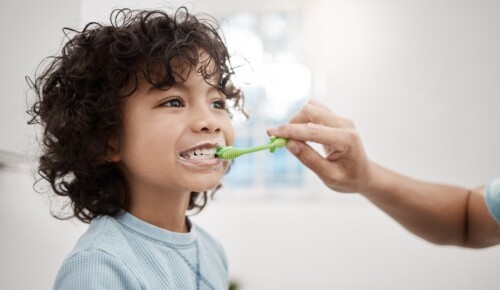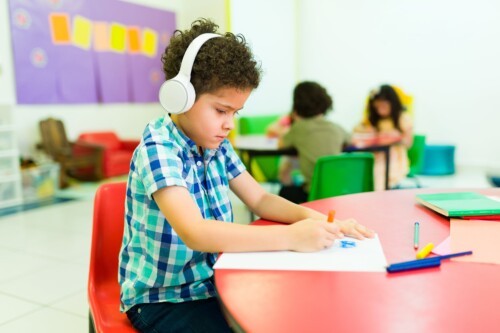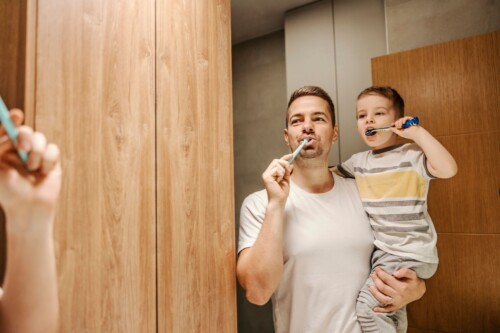April is Autism Acceptance Month. Unlike other months where the goal is to raise awareness, Autism Acceptance Month is designed to help us reach a deeper understanding of autism, neurodivergence, and honoring the unique lived experiences of autistic children and adults. Acceptance includes inclusion: how can we make public spaces that are safer and more comfortable for autistic people? How can dentists make inclusive dental practices that make space for those with autism and sensory processing difficulties?
They’re questions that don’t have easy answers. Thankfully, there are more resources than ever for those who want to understand autism and treat autistic individuals equitably and kindly.

Understanding Autistic Patients
Autism is thankfully better understood than ever, and we continue to make strides as a society in making an accessible and inclusive world. However, this month is the perfect time for every dentist to refresh their knowledge and refocus their attention on making their practice accessible for neurotypical and neurodivergent children alike.
Autism, Dental Hygiene, and Prevention
Parents and caregivers often strive to find inventive methods to educate their children on toothbrushing and maintaining good oral hygiene. While many children may resist toothbrushing in favor of other activities, those diagnosed with autism may specifically struggle due to sensitivity issues. These sensitivities are typically categorized by medical professionals as either hyposensitivity or hypersensitivity.
Hyposensitivity entails limited sensation or numbness in the oral area, which can lead to anxiety during toothbrushing. Conversely, hypersensitivity involves heightened awareness and sensation, causing discomfort during oral care routines.
Children participating in early childhood intervention and self-help programs often collaborate with occupational therapists and speech-language pathologists to enhance their oral-motor skills. Following an assessment, these experts can develop personalized treatment plans tailored to each child’s diagnosis and requirements. With adequate knowledge and practice, parents can also assist their children in achieving greater independence in self-care at home.
However, many of these tips and techniques employed by therapists and other professionals can be employed by a knowledgeable dentist. Below are several tips and techniques to aid children with autism in developing lifelong oral hygiene habits.

Establish a Routine
Establishing a dental hygiene routine for children with autism can be challenging due to sensory sensitivities and the need for a structured routine. It’s crucial to introduce dental care activities gradually, using a calm and patient approach. Begin with short sessions, slowly increasing the time spent on each activity, and use positive reinforcement to encourage cooperation and make the experience more pleasant. Introducing a visual schedule can help the child understand and anticipate each step of the dental care process, providing a sense of structure and security.
Professional dental care should also be tailored to the needs of children with autism. Prior to the visit, discussing what will happen and using stories or pictures to explain the process can help prepare the child. During the appointment, the dentist can employ techniques such as a tell-show-do approach, where they explain and demonstrate each step before performing it, to help the child remain calm and cooperative.
Lastly, consistency is key in maintaining dental hygiene habits in children with autism. Establishing a routine that is followed daily, at the same time and in the same order, can help the child develop a sense of normalcy around dental care. Involving the child in the process, such as letting them apply the toothpaste or choose the toothbrush, can also foster independence and confidence in their ability to care for their own dental hygiene. With patience, understanding, and the right approach, children with autism can develop and maintain healthy dental habits that will benefit them throughout their lives.
Preparing for the Office Visit
Prior to the visit, discuss the visit with parents. Help them learn how to prepare their child. Make an inventory of the sounds, sights, and smells that the child may experience in your office, and collaborate with parents to help communicate these details. Have them describe what will happen, using stories or pictures to explain the process can help prepare the child.
During the appointment, the dentist can employ techniques such as a tell-show-do approach, where they explain and demonstrate each step before performing it, to help the child remain calm and cooperative. The most important thing to remember when working with autistic patients is not to push forward if the child seems upset or afraid.
Often times, autistic children have difficulty regulating their emotions, and if they become too upset, the visit may need to be discontinued. To prevent this, simply forecast what you are going to do, and emphasize to the child how safe and gentle you will be.

Sensory-friendly Dental Products for Autistic Children
Select the Appropriate Toothbrush
Sensory-friendly dental products can significantly ease the dental hygiene process for children with autism.
It’s important to allow the child to choose their own dental care products when possible, as this can increase their comfort level and willingness to engage in the routine. Additionally, practicing the motions of brushing and flossing on a model or using a favorite toy can help the child become accustomed to the sensations before transitioning to their own mouth.
Traditional toothbrushes may feel unfamiliar to children with oral sensitivities. Opt for a toothbrush with soft or silicone bristles, which can help desensitize the mouth and gums. Specialty or baby toothbrushes often feature small silicone bristles, allowing children to gradually adjust to brushing sensations.
Choose Suitable Toothpaste
Children may find mint-flavored toothpaste unpleasant due to sensory sensitivities. Fortunately, there are various child-friendly flavors available, such as bubblegum or berry. Alternatively, consider unflavored or non-foaming toothpaste options to reduce sensory overload.
Experiment with Floss
Flossing is integral to oral hygiene, so let your child choose a favorite flavor and appropriate thickness. Electric or water flossers may be beneficial for those struggling with manual flossing. Similarly, if holding a manual toothbrush is challenging, try adding a tennis ball or foam grip to the handle or switch to an electric toothbrush for added stimulation.
Teach Proper Toothbrushing Techniques
Children often struggle to grasp the concept of brushing for two minutes. Utilize toothbrushes with built-in timers or play music to signify when brushing is complete. Alternatively, use a bathroom timer to establish a daily routine. Position children in front of a mirror to promote independence and guide them through each step of toothbrushing.
Begin with the hand-over-hand method, showing the child what motions are needed and what areas of the mouth they should be cleaning. Focus on brushing different areas of the mouth in a systematic manner, ensuring thorough cleaning of all surfaces. Describe what you are doing out loud, and ask for feedback from the patient regarding their comfort and understanding.

Additionally, practicing the motions of brushing and flossing on a model or using a favorite toy can help autistic patients, particularly pediatric patients, become accustomed to the sensations before transitioning to their own mouth.
Pairing with Preferred Activities
Incorporating dental care into existing daily activities or preferred routines can facilitate compliance. For instance, for infants and extremely small children, brushing can be paired with activities like bathing. Providing a comfortable environment, such as laying the child on a soft surface with visual distractions, can enhance the experience.
For slightly older pediatric patients, brushing can precede TV or technology time, or it can be paired with favorite songs and music. If a child has a preferred location in their room or the home, it may be best to begin by guiding them through the process in their preferred location to increase their comfort level before beginning brushing in the bathroom.
Just Be Consistent
Lastly, consistency is key in maintaining dental hygiene habits in children with autism. Establishing a routine that is followed daily, at the same time and in the same order, can help the child develop a sense of normalcy around dental care. Involving the child in the process, such as letting them apply the toothpaste or choose the toothbrush, can also foster independence and confidence in their ability to care for their own dental hygiene. With patience, understanding, and the right approach, children with autism can develop and maintain healthy dental habits that will benefit them throughout their lives.
Make Every Visit to the Dentist a Successful One
For more on autism, Autism Acceptance Month, and how to better help and support autistic patients, peers, and coworkers, the National Institute of Health has released a Digital Toolkit packed with resources and information based on their latest research. The CDC, also, has their own Digital Toolkit to help support youth with autism.


